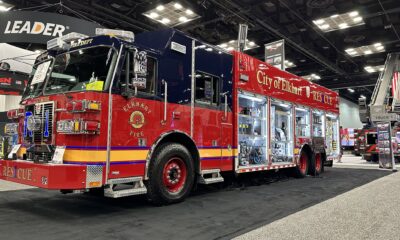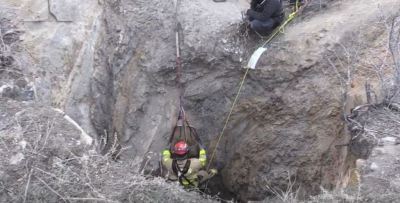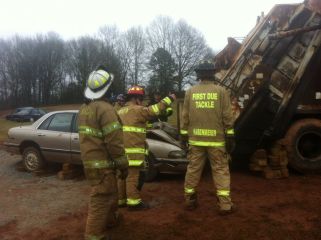Most suspended, confined-space rescue victims are working in some capacity and are using a fall-arrest system; here’s how to treat and reach those victims
In the world of confined space, most of our victims are going to be entrants who are performing work as an employee. This implies several things.
They are most likely going to be operating with some degree of compliance with industrial guidelines. These guidelines require workers at height to have Class III harnesses and fall-arrest equipment. They also are required to be rigged to a retrieval system such as a winch.
Therefore, it makes sense for rescuers to develop rescue skills that address this presentation. This can play out in two ways.
First, the victim is simply a worker at height who is attached to a fall-arrest system and falls into the confined space. The system operates properly and arrests the fall but results in a suspended victim who must be hauled out with a supplemental system.
Second, the victim is being lowered or climbing down into a confined space on a retrieval system and encounters an event (illness, injury or system malfunction) that strands him at mid height. This also requires the victim to be retrieved, but the existing winch system and high directional anchor may be inadequate to perform that task.
Treating the victim
In either of these scenarios, our first consideration is the hazards associated with the confined-space environment and the condition of the victim. We will leave hazard management for another discussion and focus on the condition of the victim.
Quickly establish a timeline and an initial assessment of the victim’s progression towards suspension trauma — a condition where the compression applied to the victim’s lower extremities by the harness causes circulatory compromise. The victim will develop toxins in their lower extremities and exhibit signs of confusion, syncope, heart palpitations and potentially cardiac arrest.
Most research suggests that this event is going to happen if the compression of the lower extremities is not relieved and the recirculation managed. However, the predictability of how fast the symptoms will progress is highly dependent upon individual body types and characteristics.
So, play it safe and assume it may progress quickly. Even if the victim is not presenting with signs and symptoms of suspension trauma, aggressively prevent it by relieving the compression. Conscious victims can be coached to relieve compression by changing their body position in the harness or stepping up with foot loops that may be a part of their harness or one lower to them.
Unconscious or incapacitated victims must be quickly retrieved. Once they are topside, gradually progress the victim from a fowlers position to a semi fowlers position over approximately a 15-minute period to prevent flooding their circulatory system with the toxins built up in their lower extremities. Laying them flat quickly may result in cardiac dysrhythmia and arrest.
Scenario One
In the first scenario, the victim was relatively close to the top side and accessible. These fall-arrest systems have limited play in them and typically don’t play out more than 24 inches once they are activated.
The most effective way to rescue these victims is to use an extension or reaching device that will allow rescuers to attach retrieval and belay lines without making entry or wasting time descending or being lowered to the victim. Victims can also help make these attachments if they are capable.
In these industrial settings, high-directional anchors, or HDAs, are almost a necessity. If structural anchors are not accessible, rescuers should have portable HDAs such as tripods, bi-pods, or mono-pods. Not developing an HDA will make the edge transition extremely challenging for the rescuers and victim.
Simple systems such as block and tackles (4:1/5:1) with integrated cams or progress capture devices are fast to deploy and very efficient in straight up and downs like this. Once the belay line and haul system are attached to the victim’s harness, the victim can be hauled up and treated.
The vast majority of industrial harnesses use dorsal or posterior rigging points. This helps in this application because the loaded arrest system pulls the rigging point up above the victim’s shoulders and leaves it readily exposed for rescuers.
Scenario Two
The second scenario involves not just a fall-arrest system but a retrieval system as well. Industrial retrieval systems present decision-making challenges.
Most of them are not compliant with rescue standards. The safety factor and load design are typically under-engineered for our needs. Additionally, victims who are not packaged or tended can become hung up on stairwells or other obstructions in the confined space.
I strongly recommend taking the time to evaluate the safety of the retrieval system before using it as a rescue tool. I also strongly recommend avoiding blind retrievals.
If they are attached to a winch but you do not have line of sight on them to ensure they are not and will not get hung up, do not start cranking the winch. Winches will not give you the same alert if the system meets unexpected resistance as will a rope-based retrieval system. I always prefer buffers for my potential mistakes or factors that may impede the rescue.
Conversely, industrial retrieval systems may facilitate the rescue. If the system is commensurate with the loads you will apply to it and is in good working order, you can use it. If it is not already attached, the winch cable can be deployed and attached to the victim using the applications from the previous scenario, and the rescue can be performed.
Remember to let the victim’s survival profile and the safety of your crew drive your decisions. Risk a lot to save a lot, and when you make a high-risk decision, do it from an informed and fully aware perspective.
Air Monitoring
Lifting Lockers
Have you walked thru your local school and thought that the lockers could fall on someone?

Outside the Box
The lifting maze training props that made the rounds across social media last year could use a little updating after looking at the pictures from the rescue call that the Medway Fire Department responded to. If you look at the pictures, the lockers appear to be several sections of lockers attached together. Lifting all the lockers as one unit may not be possible. A scenario like this will require more cribbing that a large rigid object.
Location
The custodial worker was pinned under the lockers in a second-floor hallway. This type of rescue will require a large cache of equipment. Consider the your plan A and plan B lifting tools. Airbags and battery powered extrication tools are easily deployed inside a building. If plan Z was to run a gas powered tool do you have ventilation setup along with air monitoring to ensure the patient and rescuers are not put in danger?
Weight
After a quick web search I found that the average 5-6 feet tall, 3 locker section weighs around 175 lbs. Looking at the pictures, it looks like 3, 3 locker sections fell on the worker. However, the contents of the lockers is the unknown. The lockers could be empty or full of textbooks and other items.
Closing Thoughts
Strong work by the Medway, Norfolk, Millis and Bellingham fire departments freed the pinned worker. This is another one of those calls that could happen anywhere. Nearly every school has lockers lining the hallways. Often, the hallways do not have easy access to the outside of the building and the parking lot. Keep that in mind because all the equipment will have to be carried in.
Air Monitoring
Essential Tools for Confined-Space Rescue
According to NIOSH, confined-space events are typically found to be the direct result of three common factors: a lack of recognition of hazards; a lack of testing, evaluation and monitoring; and a lack of planned rescue procedures.
According to NIOSH, confined-space events are typically found to be the direct result of three common factors: a lack of recognition of hazards; a lack of testing, evaluation and monitoring; and a lack of planned rescue procedures.
These can largely be addressed through the proper use and application of two essential pieces of equipment: atmospheric monitors and confined-space blowers or integrated-ventilation systems.
Class A confined spaces are those deemed to be IDLH (immediate dangerous to life or health) environments. The atmospheres in these confined spaces lack natural ventilation and are or have the potential to become untenable.
Before we can make entry into these spaces, OSHA requires that we evaluate and validate the atmosphere with appropriate monitors.
So what is an appropriate monitor? Here are six basic criteria to consider when selecting your monitor.
1. The atmosphere must be tested for oxygen, carbon monoxide, flammability and typically hydrogen sulfide. This requires a four-gas monitor. If the space has a specific hazard — for example many water parks or water recreation facilities will have chlorine hazards present in vaults with pumps — then special sensors can be purchased for the four-gas monitors to detect that specific chemical.
2. All monitors should be equipped with both audible and visual alarms to help alert personnel to the presence of hazardous conditions.
3. OSHA requires that the area to be occupied within the space be tested. The area is defined as a four-foot cube around the area of occupation. This requires the use of a four-gas monitor that is equipped with appropriate-length tubing and pumping capabilities so that samples can be taken prior to entry.
When dealing with confined spaces at depth, this is particularly important. Pumping a layer of the atmosphere into the monitor sensors takes a few seconds. This delay varies between manufacturers and should be a point of evaluation when selecting a four-gas monitor.
4. Monitors should be rugged, environmentally resistant and easily managed. Gas monitors should have some degree of water-drop resistance as well as clips or rigging rings that can take some abuse.
Although many confined spaces are large vault configurations that allow relatively easy movement, some are truly confining and the monitors can take a beating when we are crawling through pipes and openings.
5. Operational sequences should be simplistic and ergonomic. Entrants will often have gloves on and should be capable of operating the gas monitor with relative ease.
Additionally, gas monitors should not encumber operations within the space. The more compact and straight forward the monitor, the happier the entrants.
6. All gas monitors require calibration. Sample gasses as well as the calibration kit should be accessible and affordable. Sending monitors out for calibration can be costly and reduce operational capabilities. Selecting a gas monitor that can be calibrated in house is a more advantageous option.
Atmospheric monitoring should be initiated away from the space to establish hazard zones and progress into the space. This should be done continuously and readings should be documented every five to 10 minutes. Approaching the space with a monitor will help ensure that we don’t jump into the rescue sequence with a lack of hazard recognition.
Venting the Space
Once the atmosphere has been tested, consideration turns to ventilating the confined space. In a Class A confined space, ventilation should be applied to purge the atmospheric hazards.
Ventilation in confined spaces can be challenging and should be approached somewhat scientifically to ensure that it is done efficiently and safely. Here are four criteria for developing an effective ventilation equipment cache.
1. Ventilation blowers can be gas or electric as well as nonintrinsic or intrinsically safe. The safest option is to acquire intrinsically safe electric blowers. These have a special plug that prevents the blower from providing a source of ignition in a flammable environment.
Also, electric blowers will not produce CO as a byproduct of combustion, as will the gas-powered versions. This eliminates one more potential problem to manage.
2. Blowers come in a variety of sizes and will produce varying CFMs depending on their design and power. The greater the CFM, the faster the environment can be purged.
The down side of higher-CFM fans is size and weight. Select a blower that is somewhere in the middle between mobility and power.
3. Develop an assortment of ductwork, manhole saddles, and 90-degree bends. Every twist, turn, and tight corner in a confined space can dramatically alter the effectiveness of a ventilation operation if you are not maximizing airflow.
Look for ductwork and accessories that have good cinching mechanisms to insure that they don’t come apart once they are under pressure. Remember that each accessory reduces the fan’s CFM but the reduction is far less than that from a compressed kink in a hose that should have a rigid 90-bend accessory.
The manhole saddle accessories will also facilitate movement in and out of the space without disrupting airflow. When these reduction saddles aren’t used, ductwork often has to be removed to allow entrant access and egress.
Spaces at depth will also require extensive ductwork. Remember that a four-foot atmospheric cubicle must be maintained around the entrants. Additionally, atmospheric hazards that are heavier than air will be at the bottom of the confined spaces and will not be adequately purged with the appropriate placement of ductwork.
4. Ventilation can be performed with negative pressure, positive pressure or both. The weight and characteristics of the atmospheric hazard as well as the environmental conditions of the general area will dictate the type(s) of ventilation applied.
Selecting a blower that can be used in a positive- and negative-pressure application is ideal. It is also important to note that multiple blowers are the goal.
Many spaces may require multiple blowers used in different configurations to avoid short circuiting. The more options you have, the better equipped you will be to address the problem.
Purge-time Calculations
Purge-time calculations are frequently overlooked in confined-space ventilation, but should not be. Generally speaking, this is the time required for the air in the confined space to recirculate approximately 7.5 times. This benchmark should eliminate the presence of atmospheric hazards or at least reduce them to something tenable.
This is a relatively accepted benchmark and is calculated by dividing the cubic volume of the confined space by the CFM of the blower. Multiply this number by 7.5 to find the time required.
This calculation will help evaluate the effectiveness of ventilation operations through trending of atmospheric readings and their correlation to time. It also develops a tactical benchmark for projected time of entry.
There are a myriad of other considerations when performing confined-space operations, but understanding these two vital pieces of equipment and applying them correctly will have you on the fast track to safe and effective operations.

This content provided in partnership with FireRescue1.com
Building Collapse
Rescue PowerPoints

Below is a list of Technical Rescue PowerPoints that cover Extrication, Trench Rescue, Rope Rescue, Confined Space, Machine Rescue, Water Rescue, and Farm Rescue.
Extrication
Trench Rescue
- Trench Rescue I
- Trench & Excavation Rescue
- Trench Rescue Awareness
- Trench Rescue
- Trench Rescue Assessment
- Trench Rescue Decision Making
- Advanced Trench Rescue
Rope Rescue
- Ropes and Knots VI’ Technical Rescue
- Rope Rescue
- Rope Rescue
- Rope Rescue Operations Course Knots
- Rope Rescue
- Rope Rescue Equipment
Confined Space
- Confined Space Rescue
- Confined Space Rescue
- Confined Space Rescue Awareness
- Confined Space Rescue IDLH Atmosphere Entrant
- Confined Space (Permit-required) Rescue/ Emergency Services
- Initial Response Actions To Confined Space Emergencies
- Confined Space Rescue Operations Level
- Effects of Oxygen Deficiency
Machine Rescue
Misc Rescue
- Vehicle & Machinery Rescue
- RESCUE ENGINE 33 OPERATIONAL MANUAL
- Vehicle Extrication and Special Rescue
Water Rescue
Farm Rescue












